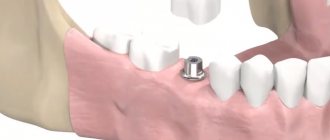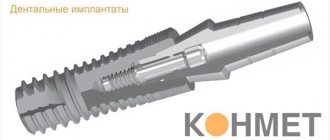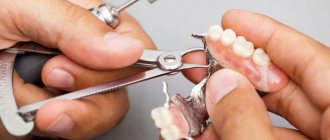Intramucosal implantation
A type of implantation that involves the installation of mini-implants and is used to obtain extremely strong fixation of removable dentures.
Removable dentures are the most inexpensive type of orthopedic structures, which have a number of disadvantages, including the inability to firmly fix the product in the oral cavity. Especially if removable prosthetics are performed in the upper jaw. Such a prosthesis can easily fall out when eating or talking, and of course this will not bring any pleasant emotions to the person. And what is important: this problem is not solved by gels, which are so widely advertised on TV. Intramucosal implantation or mini-implantation allows you to qualitatively solve the problem of fixing removable dentures, improve the aesthetics of the result of prosthetics, and relieve the patient of problems such as rubbing soft tissues with the denture or impaired diction.
Typically, this type of technology is used when there are contraindications to intraosseous implantation, and if the patient wishes to minimize his costs for dental restoration.
During the operation, special implants consisting of two parts are used. The first part of the system is fixed on a removable denture, the second is implanted into the mucous membrane. Implants of the intramucosal type are installed in holes that the implantologist forms with a bur in the gums. After the implants are implanted, a prosthesis is immediately placed on them, which is easily removed. This makes it possible to carry out high-quality oral hygiene.
USEFUL FACT: Intramucosal implantation can only be carried out if the mucosa is in good condition, namely, if its thickness is at least 2.2 millimeters.
Transosseous implantation
Another type of implantation that modern implantologists have abandoned.
This technology was used for severe bone resorption in the area of the alveolar process and for implantation in the lower jaw. If the diagnosis revealed a similar condition of the bone tissue, implantation could only be carried out using a transosseous method or after an operation to move the nerve located in the lower part of the tooth socket. But such an operation implied additional costs for the patient and not everyone agreed to it, so the doctors offered an alternative - transosseous implantation. The operation used implants of a specific type - in the form of a curved bracket with two pins, which were implanted not in the oral cavity, but in the chin area. Transosseous implantation is a complex technology and a traumatic operation; in addition, this method does not eliminate certain requirements for bone tissue. This type of implantation could not be used if the bone was below 6 millimeters and thinner than 3 millimeters.
Laser dental implantation
Laser implantation is not a separate type of implantation; this is how clinics refer to an operation during which all the incisions necessary for implantation will be made not with a scalpel, but with a laser.
This method of carrying out the operation has its advantages, including:
- Reducing the time required for surgical intervention;
- Reducing the pain of the procedure for the patient and, accordingly, reducing the dose of anesthetic drugs;
- Low traumatism, antibacterial action of the laser;
- There are no stitches, which has a positive effect on tissue recovery time.
There is essentially one downside to the laser type of dental implantation: the high price, which is much higher than the cost of traditional surgery. For comparison, turnkey implantation using a standard set of manipulations and a scalpel can cost from 35,000 rubles, the same operation, with the same implants and procedures, but with a laser - from 60,000 rubles.
USEFUL FACT: Many implantologists do not believe that laser dental implantation provides patients with any significant benefits. The implant healing period remains the same, but the patient’s costs increase significantly.
Express dental implantation
It is also not a separate type of implantation.
For the sake of beautiful advertising, clinics use the sonorous name “express implantation” to designate one-stage implantation, in which the installation of implants and a prosthesis is carried out in one operation. But the advertisement is silent about one very important detail regarding this type of implantation: it can be performed only in cases where the patient has no contraindications to surgery, there is no bone tissue atrophy, and there is enough space in the oral cavity for implantation. That is, if there are initially ideal conditions for implantation.
However, if such conditions exist, then the patient can receive a number of benefits from the use of one-stage implantation:
- Teeth can be restored in the shortest possible time and thus relieve a person from psychological discomfort and the need to limit oneself in the diet.
- One-stage implantation can be carried out in case of diabetes, hepatitis, periodontitis - conditions that are contraindications for other types of implantation.
- The patient's expenses for dental restoration are reduced, since preliminary osteoplasty is not required and, moreover, this implantation technology makes it possible to restore any number of teeth using a minimum of implants (for example, you can restore a full row of teeth with just 4 or 6 implants).
- There is no need to pay for an abutment and gum former, since implants used with one-stage technology are monolithic structures.
You can find out more useful details on one-stage implantation at an appointment with the implantologists of the Firadent clinic, which offers premium services in the field of dentistry!
Navigation implantation
Does not apply to certain types of implantation. This term refers to the use of a special program that allows you to plan in detail the operation to install implants and develop surgical templates for it. The use of templates eliminates inaccuracies when installing implants into the bone and reduces the traumatic nature of the operation. The navigation implantation service is offered to all patients of our premium dentistry in Moscow - Firadent.
Implantation without surgery
Implantation without surgery - this type of technique does not exist. This name is used for advertising and to attract clients and implies the operation is performed in a low-traumatic way, which does not exclude surgical intervention. Yes, the implantologist will not cut the patient’s gums, but to form a bone bed for the implant, he will make holes in the jaw bone with drills.
Types of implantation in complete absence of teeth
In case of complete absence of teeth, one-stage implantation using All-on-4 or All-on-6 technology is used.
These technologies make it possible to completely restore the dentition and use a limited number of implants - 4 or 6. The implants are installed in the jaw according to a certain pattern and then, immediately after the operation, a temporary prosthesis is fixed on them, which, after engraftment of the titanium rods, is replaced with a permanent orthopedic structure.
All-on-4 and All-on-6 have many advantages: these technologies make it possible to quickly restore the dentition, reduce the overall treatment time and costs for the patient, and in addition, they allow you to do without bone grafting even with diagnosed bone tissue atrophy. All-on-4 or All-on-6 are used in cases of complete edentia or when teeth are preserved in the dentition, but their treatment with conservative methods will not be effective and will not provide the opportunity to obtain a solid base for a classic prosthesis.
What is a dental implant
A dental implant is a metal structure in the form of a frame or pin that is implanted into the jaw, acting as a tooth root.
Subsequently, a permanent prosthesis is attached to the implant. An implant is necessary to secure a crown or bridges. Installing a pin does not require grinding of adjacent healthy teeth, and dentures fixed in this place will not slip or move. In addition, implants allow you to avoid atrophy of the gums and jaw muscles with age, as they imitate the root.
If we compare implants with other methods - removable dentures and crowns, then implants are much more convenient to use. The patient feels confident; there is no need to constantly remove dentures. Crowns secured to pins sit tighter and look beautiful. If you install crowns with bridges on incisors, the appearance will not be aesthetic.
What are the consequences of losing teeth in the chewing area?
Despite their reliability, molars and premolars are among the most susceptible teeth to pathogenic bacteria. This is due to their active participation in the process of chewing food products. Severe pathologies in the chewing area can provoke tooth loss. This, in turn, can cause such serious problems as deterioration of the anatomical characteristics of the face, disturbances in the functioning of the maxillofacial system, disruptions in the functioning of the gastrointestinal tract and other undesirable changes.
Currently, the most effective method of eliminating the defect is the implantation of chewing teeth. However, the procedure for reproducing molars and premolars differs in its specific features, which we will discuss later.
Types and features of dental implants
There are 6 types of implants:
- intraosseous root-shaped;
- intraosseous in the form of a plate;
- combined - plates with pins;
- subperiosteal, located under the periosteum;
- endodontic, inserted through the root apex.
- Submucosa is injected into the gum and is used to stabilize removable dentures.
The doctor chooses the implant after assessing the condition of the patient’s jaws. Intraosseous implants are the best option; they are used in most cases. The products are strong, durable, and imitate the root well.
Subperiosteal implants are installed when the bone is thinned and damaged. This product is made in the form of a frame, similar to a saddle, which is placed under the gums.
The endodontic type is used if part of the root is preserved. The product helps to lengthen the root and secure a fixed prosthesis. This method is the most gentle, as the implant takes root quickly.
Indications
Indications for dental implantation:
- complete absence of dentition;
- missing one or more teeth;
- patient's reluctance or inability to use removable dentures;
- increased wearability of enamel;
- lack of closure of teeth.
The decision on the need to install pins is made by the dentist based on the results of a comprehensive examination.
Alternative options
If there is a lack of teeth in the chewing region, an alternative treatment option may be the installation of removable orthopedic structures. However, it is not always possible to fix a bridge-type prosthetic device. Sometimes the patient only has supporting units on one side of the defect, which explains the need to use a removable prosthetic system that is fixed to these teeth and gums.
Removable prosthesis. This is a fairly low-cost system that is accessible to the vast majority of patients. However, along with the effectiveness of this design, there are some negative aspects associated with its operation:
- Uncomfortable to wear. Due to the presence of a massive acrylic base, the prosthetic device can cause irritation of the gum tissue;
- Insufficiently strong fixation. Many patients resort to the use of additional gels, ointments and adhesives;
- Light load. Due to the lack of necessary pressure on the bone, it undergoes further resorption. Over time, this deteriorates the strength of the prosthetic device and leads to the need for its relocation.
Taking into account the above disadvantages, we can judge the advisability of installing dental implants instead of removable prosthetic devices using one’s own teeth as supports.
Author:
Contraindications
Dental implantation is a complex surgical operation that has a wide range of contraindications, both absolute and relative.
The procedure is completely contraindicated in the following cases:
- with severe mental disorders;
- for cancer of any origin;
- if a blood clotting disorder is detected;
- for severe autoimmune and rheumatic pathologies;
- for tuberculosis;
- for diabetes mellitus;
- for osteoporosis.
Relative contraindications include conditions that must first be cured, and only then think about surgery:
- caries;
- gingivitis, stomatitis;
- periodontitis;
- hormonal imbalance can cause pin rejection;
- pregnancy period;
- breastfeeding period;
- childhood;
- smoking, alcoholism and drug addiction;
- anorexia;
- insufficient oral hygiene;
- acute respiratory diseases;
- rehabilitation after injuries, operations, radiation therapy.
After eliminating the relative contraindication, implantation can be performed on the recommendation of the dentist.
Stock
-6%
BASAL COMPLEX - Restoration of teeth on 1 jaw in 3 days 265,000 rub.
250,000 rub.
get -19 %
German implants XIVE Friadent 80,000 rub.
65,000 rub.
get -20 %
Dental implantation RUB 20,000.
25000 rub. 20,000 rub.
get -13 %
Removable overdenture on 4 implants RUB 150,000.
130,000 rub. get
Types of dental implantation
All clinical cases encountered by dentists are individual. Especially when it comes to dental prosthetics. The implantation method is recommended to the patient after examination and assessment of the condition of the jaw bones and surrounding tissues. Currently, the following methods exist:
- classic two-stage with delayed loading;
- basal one-stage with immediate load;
- immediate or express implantation immediately after removal;
- mini-implantation, using small pins;
- combined.
Mini-implantation is used for additional fixation of a removable denture. Combined is used to treat several teeth in a short period of time. In this case, the restoration of the anterior incisors is carried out using a one-step technology, and large molars using the classical technology. Let's look at the other methods in more detail.
Classical
The classical technique can be called universal, since it is carried out for any medical indication. This method is effective when it is not possible to immediately achieve stability of the implant or bone grafting is required. If you put stress on a tooth prematurely, there is a high risk of rejection.
The classical method is carried out in 2 stages:
- Implantation. An operation is performed, a pin is secured with a plug, and the gum is sutured.
- Prosthetics. After 4-6 months, when the implant has taken root, an operation is performed to open it, and a gum former is installed. When the wound heals, an abutment and a plastic crown are installed. After 3 months, the crown is replaced with a permanent one.
Classical technology is famous for its good implant survival rate. In addition, the doctor has the opportunity to shape the gums beautifully and achieve a beautiful result. The disadvantage of the technique is long-term treatment, from 4 to 8 months and repeated surgery.
One-step
The one-stage technique involves installing an implant immediately after tooth extraction. This technology is often used for the restoration of anterior incisors, since not all patients are ready to live for months with a large gap in the smile area.
Simultaneous implantation is carried out in two ways:
- with immediate prosthetics;
- with delayed prosthetics.
With immediate prosthetics, immediately after tooth extraction, an implant with a gum former is inserted and sutures are applied. After the wound has healed, the former is removed and the abutment and crown are installed.
With delayed prosthetics, the abutment and crown are installed after 3-6 months, when osseointegration is complete. When restoring chewing teeth, it is recommended to choose a delayed technique, since the chewing load can lead to rejection of the pin.
Simultaneous implantation is not possible if the bone density is insufficient.
Basal
Basal technology with immediate load involves the introduction of a structure into the deep layers of the jaw, in particular, into the basal layer, which is characterized by increased density.
The procedure is called one-stage, since the implantation of pins and prosthetics occurs with an interval of 3-5 days. Due to the deep placement of the implant, there is no need to wait for complete osseointegration. The load during chewing is evenly distributed to the jaw bones.
When is bone grafting needed?
Lack of bone leads to gum loss, and this negatively affects the aesthetics of the smile area and the osseo-fixation of the implant. Therefore, before installation, the dentist may even recommend undergoing multislice tomography (rather than standard cone-beam) in order to accurately assess the volume and condition of the bone. Further treatment can go in the following directions:
- bone augmentation before implant installation: used in a classic two-stage treatment protocol. First, the bone is surgically replanted, then they wait for it to heal (about 6 months), and only then the implant is installed,
- bone grafting during implant installation: a faster way, and also a reliable one - there is no risk that by the time the “roots” are implanted, the bone will again lose volume (as could be the case in the previous case). Used for protocols with early loading.
How does implantation work?
The duration of implantation depends on the chosen technique, but in each case the procedure is divided into 4 stages:
- planning;
- preparation for surgery;
- surgery to install an implant;
- fixation of a crown or bridge.
Before proceeding with the operation, it is necessary to determine whether intervention is possible in a particular case. During planning, the implantologist assesses the condition of the oral cavity and jaw bone tissue, studies the patient’s medical history to exclude contraindications to the procedure.
Implantation is a complex operation that cannot be performed for some chronic pathologies. To exclude them, the patient takes blood tests and takes an x-ray of the jaw bones. At this stage, the doctor decides on the need for prosthetics and gives recommendations on the choice of technique.
Get a consultation
We will answer all your questions before visiting the clinic!
+7
Online registration
Healing period for the best implants
On average, the time for osseointegration of dental implants using the traditional method is close to 6 months. However, today many manufacturers are introducing the latest developments, due to which they can reduce this period to 4-8 weeks.
Some patients consider this point to be the most important when searching for an answer to the question: “Which are the best dental implants?”
Indications for implantation
Most companies offer implantation systems that can be used in one-stage and two-stage techniques. The possibility of implant fixation in case of hepatitis, diabetes mellitus and insufficient bone tissue is already the prerogative of top brands. Not all manufacturers use technologies that allow the installation of dental implants in the presence of serious restrictions. However, if you are wondering which dental implant is better, this is a point you should pay attention to. High-quality systems produced by prestigious companies are usually allowed for fixation if there are contraindications.
Preparatory stage
If there are no contraindications to surgery, preparation of the oral cavity for implant installation begins. The dentist identifies areas affected by caries and carries out sanitation, removing objects that are subject to prosthetics. At this time, the doctor performs a computed tomography scan or orthopantomogram to examine in detail the condition of the gums and jaw bones.
Surgical stage
During the surgical stage, the implant is directly installed. With the one-step technique, the structure is installed immediately after tooth extraction.
If during the preparatory stage areas of bone tissue deficiency were identified, a sinus lift procedure is performed. The technique involves increasing the volume and height of bone tissue, compacting it so that it is possible to further secure the pins. The procedure is performed under anesthesia and takes from 60 to 90 minutes.
Sinus lift is indicated in the following cases:
- With atrophy of bone tissue due to prolonged absence of a tooth.
- If bone tissue is lost due to traumatic removal.
- With individual structural features, when the maxillary sinus is large.
After sinus lifting, you will need to wait 3-4 months; only after the material has been fixed can you begin to fix the implant.
If there is enough bone tissue, an operation to insert an implant is performed. The doctor cuts or punctures the gum, makes indentations in the bone, installs a pin or plate, and sutures the gum. You should wait for complete osseointegration before proceeding to the next stage.
Abutment installation
An abutment is an implant element that is placed above the bone to secure a crown or bridge. It is recommended to fix the abutment after the gums have healed and the implant has been implanted.
To install the abutment, the doctor opens the gum, removes the plug from the pin, and then screws in the product. The holes for the abutment screw are closed with a temporary filling.
The product is made from various materials - plastic, ceramics, metal and their combinations. According to their purpose, abutments are divided into:
- Gum former. A temporary abutment that prepares the gums for the installation of a permanent product and crown.
- Standard. Sold ready-made, not adjusted to the anatomical characteristics of the patient. Such products are produced in different sizes and are inexpensive.
- Angular. A type of standard abutment, which is made at an angle.
- Individual. It is made for the patient, taking into account anatomical features.
- Ball. It is made in the form of a rod with a ball at the end. Difficult to produce and expensive, but it holds the crown more securely.
After installing the abutment, you will have to wait 7 to 14 days for the gums to heal completely. The first two days after the operation you can clean the oral cavity; on the 2-3rd day you are allowed to carefully clean the area where the abutment is installed with a soft brush. Plaque should not be allowed to accumulate in this area.
Orthopedic stage
The last stage is the manufacture of the prosthesis and its installation. First, the implantologist makes impressions of the jaws, and a crown or bridge is made from the impressions. When producing crowns, the shade is selected so that the dentition looks realistic.
Fastening is carried out in the following ways:
- crowns and bridges - on the abutment, using cement or screw fastening;
- the removable one is fixed using a screw fastening, on a beam or using a push-button fixation method.
Once the permanent crowns are installed, the procedure is completed.
What does the cost depend on?
How much does a front tooth implant cost? In general, the cost depends on many factors: the type of implants (different brands of implants belong to different price categories), the need for preliminary preparation of the oral cavity, especially if bone grafting is required, as well as the selected material for the crowns. When visiting a free consultation with a dentist, you will be able to select the best options for each individual patient and draw up different treatment plans, indicating the cost and stages. Implantation is an expensive prosthetic option, but the cost of such treatment is justified by its long service life and functionality.
How much does it cost to place an implant in Moscow and the regions? The price of front tooth implantation is “turnkey” – i.e. with examination, installation of an implant and a permanent crown, it can cost 40 thousand rubles, or 100 thousand - depending on which implant and which crown the patient chose.
[1] Matveeva A.I., Frolov V.A., Gvetadze R.Sh., Borisov A.G., Kushkhabiev 3.3. The influence of implant parameters on the stress-strain state of bone tissue in the implantation zone // Dentistry. - 2010. - No. 1. - P. 54-55.
Author: Bespalov R. D. (Thank you for your help in writing the article and the information provided)
Dental implant technologies
Modern dentistry is constantly evolving; every year patients are offered new technologies for treatment, extraction and prosthetics. When choosing a technique, you should pay attention to such factors as the condition of the jaws, the patient’s desire to wait a long time, and the amount of money that the patient is willing to spend on restoration.
Implantation technologies are distinguished by the method of fastening the structure:
- root-shaped.
- under the mucous membrane of the oral cavity;
- through the jaw bones;
- between bone and periosteum;
The best option for replacing one or more teeth is a root-shaped product, which is a threaded pin that imitates a root. The pin is screwed into the bone tissue, and the crown is fixed on top. This technology allows you to get a beautiful smile for many years and prevent bone and mucous atrophy. The disadvantage of this method is that it cannot be used if the bone tissue has already atrophied and cannot be restored.
Technologies are also distinguished by the method of operation. To install the structure, an incision is made in the gums, which can be done either classically - using a scalpel, or minimally invasive - using a laser.
Intramucosal
Intramucosal technology involves fixing the structure under the soft tissue of the gums. The technique is used to stabilize a removable denture; it is not suitable for installing crowns.
Such products are elastic plates and buttons that are placed in soft tissues. A part remains above the gum that connects to the removable denture, similar to a snap fastener on clothing. Thanks to the product, wearing a removable denture becomes much more pleasant, as it is securely fixed.
The indication for the use of the technique is the patient wearing removable dentures, as well as the impossibility of using other implantation techniques due to bone tissue atrophy. The only requirement for installing an intramucosal implant is sufficient gum thickness.
Transosseous
Transosseous implantation involves installing an implant in the form of a bracket on which pins are attached. This type of brace is attached to the chin and mouth. To carry out the procedure, you need to make an incision in the jaw from the outside and insert a staple. The pins protruding from the mouth will be used to install the denture.
This technique is considered outdated and is used in rare cases, with bone tissue atrophy. It entails a painful recovery period, and visible scars may remain on the face. Often the transosseous technique ends in complications and rejection of the structure due to the inflammatory process.
Modern prosthetic methods make it possible to install an implant without cutting the soft tissue of the jaw and without a difficult rehabilitation period. Thanks to the sinus lift technique, it became possible to restore bone tissue and perform surgery using the classical technique.
Subperiosteal
The subperiosteal technique involves fixing the structure under the periosteum without penetrating into the bone tissue. In this case, the implant has the form of a saddle-shaped frame onto which the dentition is attached.
The technology is indicated in cases where it is not possible to install a pin:
- with bone tissue atrophy;
- with insufficient size of the alveolar zone;
- if it is not possible to perform a sinus lift procedure.
The product is made individually for each patient using impressions. First, the doctor cuts the gum, places the structure under the periosteum without damaging it, then the wound is sutured. After the structure has healed, a bridge is placed.
"All on four"
All-on-4 or All-on-4 technology is used to replace all teeth. The technique consists of fixing 4 structures on each jaw, onto which dentures will subsequently be attached. The technology is indicated in the following cases:
- if a large number of teeth or an entire row are missing;
- with bone tissue atrophy and the impossibility of sinus lift;
- hypermobility of teeth;
- no desire to wear removable dentures.
Prosthetics takes place in 2 stages. First, the remaining teeth are removed and titanium posts are installed. Then the doctor makes impressions of the jaws, from which one-piece dentures will be made. After 3-6 months, when osseointegration is complete, a permanent prosthesis is installed.
Laser implantation
Laser implantation differs from other technologies in the method of surgical intervention. In this case, the gum incision is made using a laser, which has its advantages:
- high accuracy of impact;
- immediate cauterization of tissue, which eliminates further infection;
- there is no bleeding, hematomas or swelling;
- the procedure proceeds faster;
- laser surgery is less painful than classical surgery.
After a conventional operation using a scalpel, inflammatory processes occur more often, and the wound healing process takes longer. The only drawback of laser technology is the increased cost of the service.
Comments
I have been missing teeth since birth due to pathology (cleft lip and cleft palate). Is it possible for me to get implants and which ones? Which implantation method is best for me?
Anna (07/09/2018 at 10:09 am) Reply to comment
To be honest, it looks scary, but this is really a solution if you have a problem with your teeth. Are there any guarantees that the implant will take root and there will be no rejection? Are there any compatibility tests needed? How can I check this?
Oleg (07/10/2018 at 07:51) Reply to comment
Wow, so much technology! Of course, it looks a little scary, but the prices are much more frightening; will prices for prosthetics be affordable for the population at least in the next 10 years?
Lyudmila (07/10/2018 at 08:56) Reply to comment
This is truly a solution for people who have lost their teeth. The pictures, of course, are not for the faint of heart, but the result is good. What is the maximum time for implantation of artificial roots?
Ekaterina (07/10/2018 at 09:43) Reply to comment
The screws screwed into the skull look, to put it mildly, frightening, it probably hurts, I mean after the operation, when the anesthesia stops working, how does this period go, what is used to numb the pain?
Alina (07/10/2018 at 10:07 am) Reply to comment
There are really a lot of implantation methods, when there is a choice it is always pleasant and encouraging, but where is the guarantee that these technologies will certainly be suitable and will not be rejected by the body, what tests are needed?
Olga (07/10/2018 at 10:48 am) Reply to comment
I would like to know in what cases is one-stage dental implantation impossible? In some situations it sounds somewhat vague. And so, the method is absolutely wonderful.
Sasha (07/12/2018 at 10:19 am) Reply to comment
There are quite a few implantation methods now, each is good in its own way, but looks a little scary. I wonder how painful this procedure is, how long does it take for the mouth to completely heal?
Vika (07/12/2018 at 12:15) Reply to comment
Bad gums from birth and the enamel constantly crumbles! I placed a couple of Swiss implants, one of them began to cause gum irritation after 2 years! Tell me, is it possible to combine implants from different manufacturers? and is it possible to treat an “irritant implant” without eliminating and replacing it?
Andrey (07/12/2018 at 12:43 pm) Reply to comment
It seemed to me that there are only 1, maximum 2 methods of implantation, and there are so many of them, this is encouraging, but still, what is the likelihood that the implant will take root and will not be rejected by the body as a foreign body?
Vita (07/12/2018 at 01:24 pm) Reply to comment
Each technology has its own characteristics and is good in its own way, but the price is sky-high, I need to save for several years, while denying myself everything. I wonder if there will be a downward trend in prices, as all technologies become available over time!?
Claudia (07/12/2018 at 01:27 pm) Reply to comment
I'm surprised at the huge variety of implantation methods. After reading about all the pros and cons of this method, I decided to undergo this procedure. Now I’m very curious, how much will all this cost?
Dmitry (07/16/2018 at 01:22 pm) Reply to comment
I have one problem tooth. The doctor said that we need to put pins and then restore it. Only the walls of the tooth will remain. I’m thinking, maybe it’s easier to remove such a tooth and install implants?
Irina (07/16/2018 at 18:42) Reply to comment
so how much does this pleasure cost?
admin (07/20/2018 at 08:50) Reply to comment
To be honest, I’m a novice in this area, but thanks to your article, I’m now a little more aware. Yes, there are still disadvantages, especially with aesthetics. I'm wondering, can implants always be installed or are there any exceptions? If so, which ones?
Anton (08/07/2018 at 14:28) Reply to comment
I am inclined to favor Israeli-made Alpha Bio implants, they are captivated by their good characteristics and affordable price. Tell me, are they suitable for immediate implantation?
Varvara (08/07/2018 at 15:08) Reply to comment
It looks scary, of course, but there is no other way out if your teeth are failing. What do they do if the implant is nevertheless rejected by the body? Will drug treatment follow or will the implant have to be completely unscrewed? And if the body rejects an implant made of one material, then what are the chances of an implant made of another to take root?
Arina (08/07/2018 at 15:10) Reply to comment
Write your comment Cancel reply
Alternatives to Dental Implants
Currently, there are 2 types of prosthetics, in addition to implantation:
- installing a crown if the tooth root is alive;
- removable dentures.
If for some reason surgical intervention is not possible, patients are recommended to have removable dentures. They will help restore chewing function and aesthetic appearance. But the technique has its drawbacks. The removable structure can fall out, they often break and the patient does not always get used to them quickly. The product can press and rub for a long time.
Is it possible to secure a full denture with mini-implants?
Full mini-implantation was very popular five years ago - just a few thin implants, which were placed in a matter of minutes without massive incisions, made a real revolution among patients. And many doctors took up this idea - mainly to make money. But in reality, it was immediately clear: such implants are thinner and smaller. They cannot become a full-fledged support for the prosthesis and an alternative to standard-sized models - they simply will not withstand any chewing load. Therefore, the only option when their use can be considered is as temporary support for removable dentures. For example, at the stage of preparation for the main implantation or in a situation where implantation is impossible right now due to health reasons, you first need to undergo appropriate treatment.
Service life and how to care for implants
The service life of high-quality implants ranges from 10 to 25 years or for life. A low-quality implant may be rejected after 1-5 years, and it is not always possible to replace it.
It is not always possible to understand that a structure requires replacement. In some cases, the patient begins to be bothered by obvious symptoms - the gums rise or swell, and hurt. In others, the pathology is noticed by the doctor during an examination. Dentists recommend visiting a doctor annually for preventive purposes, even after restoration of the entire oral cavity.
Possible reasons for the end of the implant’s service life:
- injury;
- design rejection;
- peri-implantitis.
The service life of crowns depends on the material from which it is made. A plastic crown will last only 2-3 years, and a metal-ceramic crown will last 10-15 years.
To minimize the likelihood of complications, follow these recommendations:
- Be responsible when choosing a clinic and doctor. Sometimes it is better to overpay a little, but be confident in the high professionalism of the doctor. A common cause of construction failure is incorrect actions by the implantologist.
- Stop smoking. Cigarette smoke provokes mucosal irritation and inflammation, and damages crowns.
- Do not place excessive stress on the implant. Do not crack nuts with dentures or open bottles.
- Perform oral hygiene daily morning and evening, use dental floss throughout the day, and give preference to an electric toothbrush.
- Get an annual dental checkup and professional cleaning.
- Avoid facial injuries.
Following these rules will help you maintain a beautiful smile for many years.











